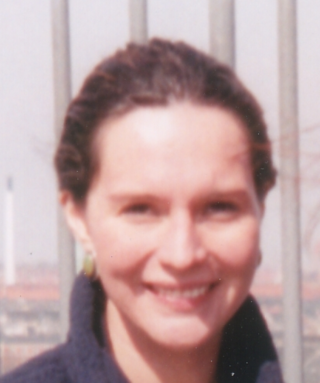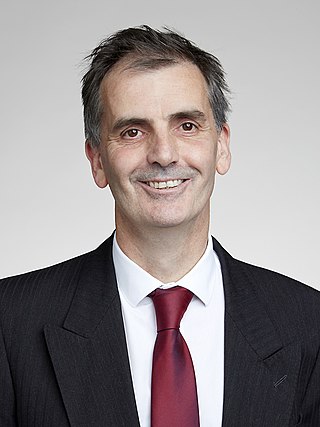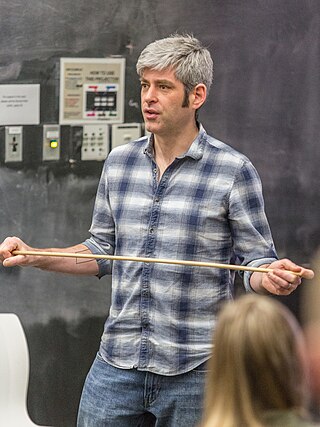
The Liverpool Telescope (LT) is a two-metre-aperture robotic Ritchey–Chrétien telescope that observes autonomously. However professional astronomers, school groups and other credible registered users submit specifications to be considered by its robotic control system (RCS) at any time using an online graphical user interface. Each night the RCS decides among these choices, and among any notified or glimpsed transient events, what to observe, based on target visibility and weather conditions.
Andreja Gomboc, is a Slovenian astrophysicist.
The eSTAR project was a multi-agent system that aimed to implement a heterogeneous network of robotic telescopes for automated observing, and ground-based follow-up to transient events. The project is a joint collaboration between the Astrophysics Group of the University of Exeter and the Astrophysics Research Institute at Liverpool John Moores University. The project was led by Alasdair Allan and Tim Naylor at the University of Exeter, and Iain Steele at Liverpool John Moores University. The eSTAR Project was affiliated with the RoboNet Consortium, and the global Heterogeneous Telescope Networks Consortium.
RoboNet-1.0 was a prototype global network of UK-built 2-metre robotic telescopes, the largest of their kind in the world, comprising the Liverpool Telescope on La Palma, the Faulkes Telescope North on Maui (Hawaii), and the Faulkes Telescope South in Australia, managed by a consortium of ten UK universities under the lead of Liverpool John Moores University. For the technological aims of integrating a global network to act effectively as a single instrument, and maximizing the scientific return by applying the newest developments in e-Science, RoboNet adopted the intelligent-agent architecture devised and maintained by the eSTAR project.

The Indian Centre for Space Physics (ICSP) is an Indian non-profit research organisation dedicated to carrying out advanced research in astronomy, astrophysics and space science. It is a sister institute of the University of Calcutta and the University of Gour Banga. It is located in the southern part of the city of Kolkata. It is shifting to its new Integrated campus on the Eastern metropolitan bypass 50 meters from Jyotirindra Nandy Metro station behind Metro Cash and Carry. Its Ionospheric and Earthquake Research Centre and optical observatory (IERCOO) where a 24-inch optical telescope (Vashista) has been installed. School and college students regularly carry out sky watching using its 10-inch telescope (Arundhati). The ground floor of the Integrated Campus will have an Astronomy and Space Museum which will be inaugurated very soon.

Gamma-ray astronomy is the astronomical observation of gamma rays, the most energetic form of electromagnetic radiation, with photon energies above 100 keV. Radiation below 100 keV is classified as X-rays and is the subject of X-ray astronomy.

Alicia Margarita Soderberg is an American astrophysicist whose research focused on supernovae. She was an assistant professor of Astronomy at Harvard University and a postdoctoral fellow at the Harvard-Smithsonian Center for Astrophysics.

Priyamvada (Priya) Natarajan is a professor in the departments of astronomy and physics at Yale University. She is noted for her work in mapping dark matter and dark energy, particularly with her work in gravitational lensing, and in models describing the assembly and accretion histories of supermassive black holes. She authored the book Mapping the Heavens: The Radical Scientific Ideas That Reveal the Cosmos.

Gerald Jay (Jerry) Fishman is an American research astrophysicist, specializing in gamma-ray astronomy. His research interests also include space and nuclear instrumentation and radiation in space. A native of St. Louis, Missouri, Fishman obtained a B.S. with Honors degree in physics from the University of Missouri in 1965, followed by M.S. and Ph.D. degrees in space science from Rice University in 1968 and 1970, respectively.

The Astrophysics Research Institute (ARI) is an astronomy and astrophysics research institute in Merseyside, UK. Formed in 1992, it stood on the Twelve Quays site in Birkenhead from 1998 until June 2013 when it relocated to the Liverpool Science Park in Liverpool. It is in the top 1% of institutions in the field of space science as measured by total citations.

James Scott Dunlop is a Scottish astronomer and academic. He is Professor of Extragalactic Astronomy at the Institute for Astronomy, an institute within the School of Physics and Astronomy at the University of Edinburgh.

Vassiliki Kalogera is a Greek astrophysicist. She is a professor at Northwestern University and the Director of the Center for Interdisciplinary Exploration and Research in Astrophysics (CIERA). She is a leading member of the LIGO Collaboration that observed gravitational waves in 2015.
Lynn Cominsky is an American astrophysicist and educator. She was the Chair of Astronomy and Physics at Sonoma State University in Rohnert Park, California from August 2004 through August 2019. She is currently the Project Director for the NASA Education and Public Outreach Group.

Hiranya Vajramani Peiris is a British astrophysicist at the University of Cambridge, University College London, and Stockholm University, best known for her work on the cosmic microwave background radiation. She was one of 27 scientists who received the Breakthrough Prize in Fundamental Physics in 2018 for their "detailed maps of the early universe."

Daniel Wayne Hooper is an American cosmologist and particle physicist specializing in the areas of dark matter, cosmic rays, and neutrino astrophysics. He is a senior scientist at Fermi National Accelerator Laboratory and a professor of astronomy and astrophysics at the University of Chicago.

Suzanne Aigrain is a Professor of Astrophysics at the University of Oxford and a Fellow of All Souls College, Oxford. She studies exoplanets and stellar variability.
María Magdalena González Sánchez is a Mexican astrophysicist, nuclear physicist, researcher, and professor best known for her contributions in gamma ray research and for being the head of the High Altitude Water Cherenkov Experiment (HAWC). She has published 90 articles about her field of study in indexed journals. In 2015 she received the Sor Juana Inés de la Cruz Recognition from the National Autonomous University of Mexico (UNAM).
Reshmi Mukherjee is an Indian-American astrophysicist known for her research on gamma-ray astronomy and blazars, involving work based on the Compton Gamma Ray Observatory, VERITAS, Energetic Gamma Ray Experiment Telescope (EGRET), and Cherenkov Telescope Array collaborations. She is Helen Goodhart Altschul Professor of Physics & Astronomy at Barnard College.
Elizabeth Anne Hays is an American astrophysicist at the NASA Goddard Space Flight Center, where she is chief of the Astroparticle Physics Laboratory and the project scientist for the Fermi Gamma-ray Space Telescope. Her research has included gamma-ray astronomy of the Crab Nebula, novae, and gamma-ray bursts.
Mary Paula Chadwick is a British physicist who is professor and head of the Department of Physics at Durham University. Her research investigates gamma-ray astronomy and astroparticle physics. She is involved with the Cherenkov Telescope Array.












